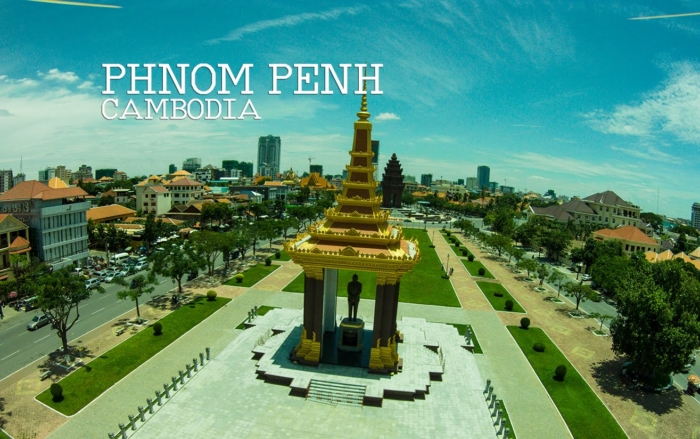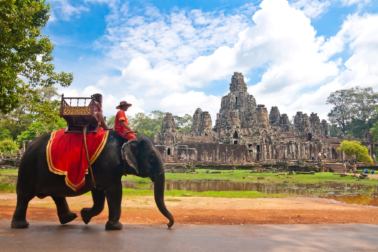Phnom Penh is the capital and largest city of Cambodia, located at the confluence of the Mekong and the Tonle Sap rivers.

Despite being a bit rough on the edges, Phnom Penh retains its former charm as a leafy South East Asian capital with a nice riverside promenade and numerous beautiful Cambodian Buddhist wats, palaces, and other artifacts. A large infrastructure catering to tourists makes it easily accessible, and many consider it to be one of the friendliest capitals in Asia, as Cambodians have not yet become jaded by mass tourism. Widespread poverty can still be seen, as in all of Cambodia, and increasing traffic can be a problem at certain times of the day.
It is a bit unfortunate that one of the tourist industry’s selling points for Phnom Penh has to do with wars that took place in the 1970’s (i.e. Killing Fields, Toul Sleng), as tourists may associate the city with these historical events when in fact Cambodian culture, including its art and music is quite remarkable and modern day Cambodia is a friendly and youthful place that has nothing to do with remote dark chapters in the country’s history.
Phnom Penh is slowly gaining high rise buildings, traffic lights, and Western style shopping malls, but overall remains one of the most undeveloped capitals in Asia. It does not have the huge colonial British architectural heritage like Yangon in Myanmar, and is light years behind Bangkok.
The beauty that made it a ‘Paris of the East’ before 1970 is hidden beneath the reality of modern day Cambodia, though there are a few French colonial buildings remaining. The wide boulevards and promenades envisaged by the French are mostly used as parking spaces and market stalls: pedestrians are not in favour. The Khmer temples and monuments found here are some of the most stunning examples of Buddhist architecture and art, and Phnom Penh has no shortage of these.
The innermost part of the city, known as “riverside” is where most tourists will go, as it hosts cafés and restaurants aplenty. Standard tourist sights are few, which makes the city a place to relax, watch the street life and absorb the local colour. Phnom Penh is a worthwhile destination for those who enjoy an ‘edgy’ experience as well as those interested in authentic South East Asian people and culture.
Tuk tuk and motorcycle drivers and beggars abound, especially in the tourist strip along the river. Cambodian drivers have a bad habit of engaging every single foreigner they see, so walking around you will constantly get stopped with offers for rides. Even expats living in the city have to deal with this constantly. The best strategy is: 1) keep your head down and walk briskly past drivers not making eye contact 2) if the driver who calls you is not close, just pretend you don’t hear or yell “no thanks” 3) if he is right next to you, just say “no, thanks” or if you really want to act like an expat say “aht-tey bohng” (for men up to age 50) or “aht-tey pooh” (for men over 50). This means no in Cambodian with the proper address. As soon as you make eye contact with them they see you as a serious customer and will try to sell you trips or make friends with you.
Weather in Phnom Penh, simply put, is of three types: 1) hot 2) too hot, and 3) too hot plus too humid. The Khmer call these the cold season, the warm season, and the rainy season, respectively. As of 2016 unfortunately the “cold” season seems to be disappearing and even when it should be hot, it’s actually too hot. This might be due to the El Nino phenomenon this year and hopefully following years will be back to the “cold” (i.e. 30 degrees celsius) again.
Weather is pleasant during the “cold season” from November to January, highs are around 30 degrees C. Staring February the temperature begins to rise, and by March the daily highs are 35-38 degrees C, making it hardly bearable. This is followed by the rainy season, which is more humid than rainy, as on most days it just rains briefly in the afternoon. Arguably, the humid heat of rainy season is even worse than the extreme heat of hot season. Occasionally, there are massive downpours that cause major flooding, making parts of the city inaccessible.
Motor vehicle generated pollution level could get very high, especially in the popular tourist area and therefore, you will feel your lung capacity drop after a few days. If you take any medication for issues such as asthma, take them with you.
History
The Khmer people have a very rich and ancient history in the region, including the famous Angkor Empire which extended over a large part of South East Asia. Unfortunately the 20th century was not kind to the Khmers, as they experienced possibly the worst genocide outside of World War II (looking at the percentage of population killed), committed by brutal and psychopathic dictator Pol Pot and his Red Khmer, who wanted to institute an agrarian communist system.
In 1975 Phnom Penh was choked with up to 2 million refugees from the war between the then US-backed government and the Khmer Rouge. The city fell to the Khmer Rouge in 1975, who completely emptied it of civilians and allowed it to crumble for several years. The city’s small class of skilled or educated professionals was systematically murdered by Pol Pot’s henchmen, or fled into exile.
Cambodia’s developing economy and institutionalized corruption have concentrated wealth into a new rich class that now supports Phnom Penh’s new fancy hotels and restaurants. Increasing tourist numbers are also bringing about improving tourist infrastructure.
The unfortunate history of the Khmers in the late 20th century is, however, just one part of their history dating back to ancient times, and modern day Cambodians are upbeat and look to the future as opposed to dwelling on the past.

